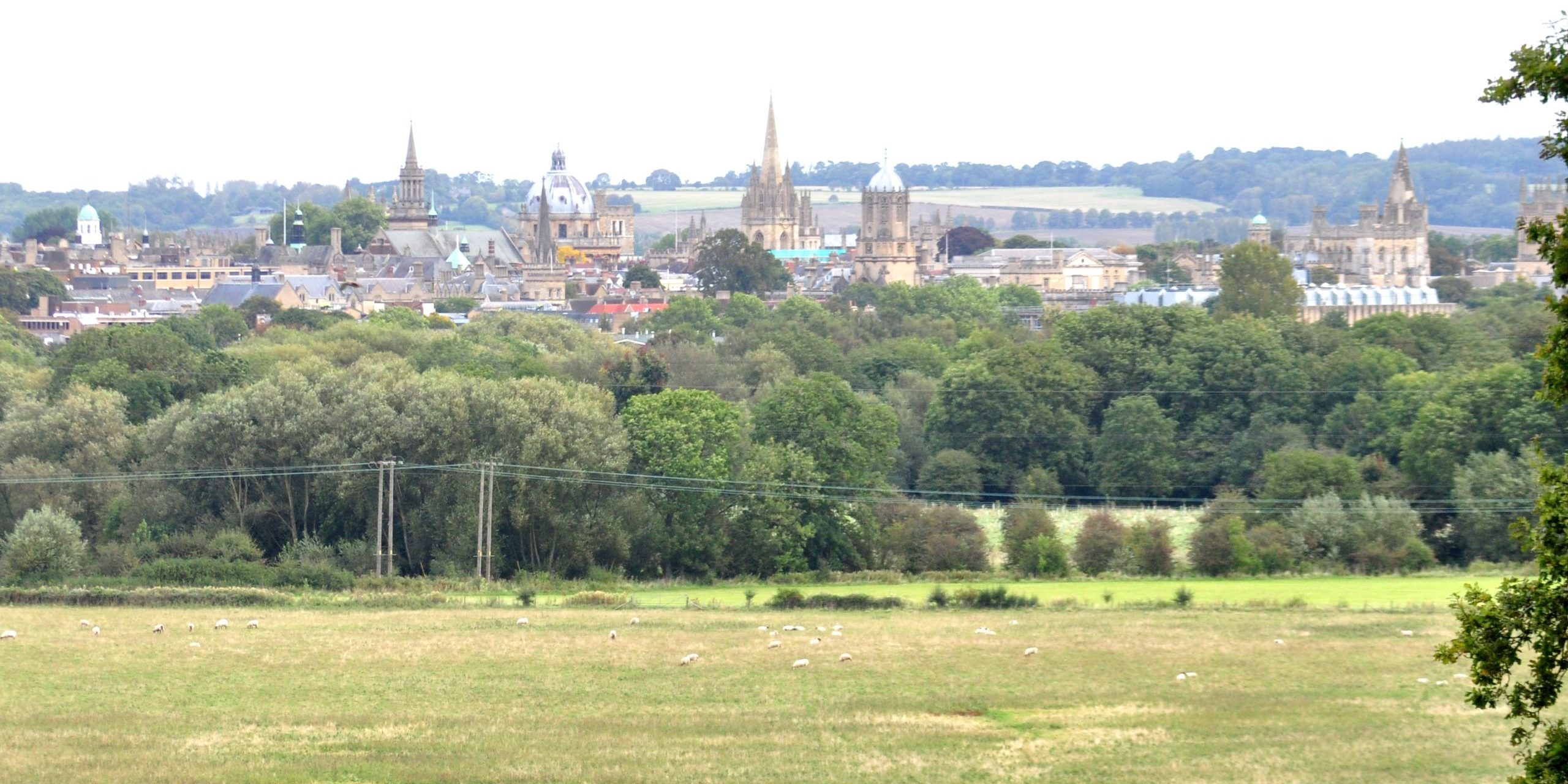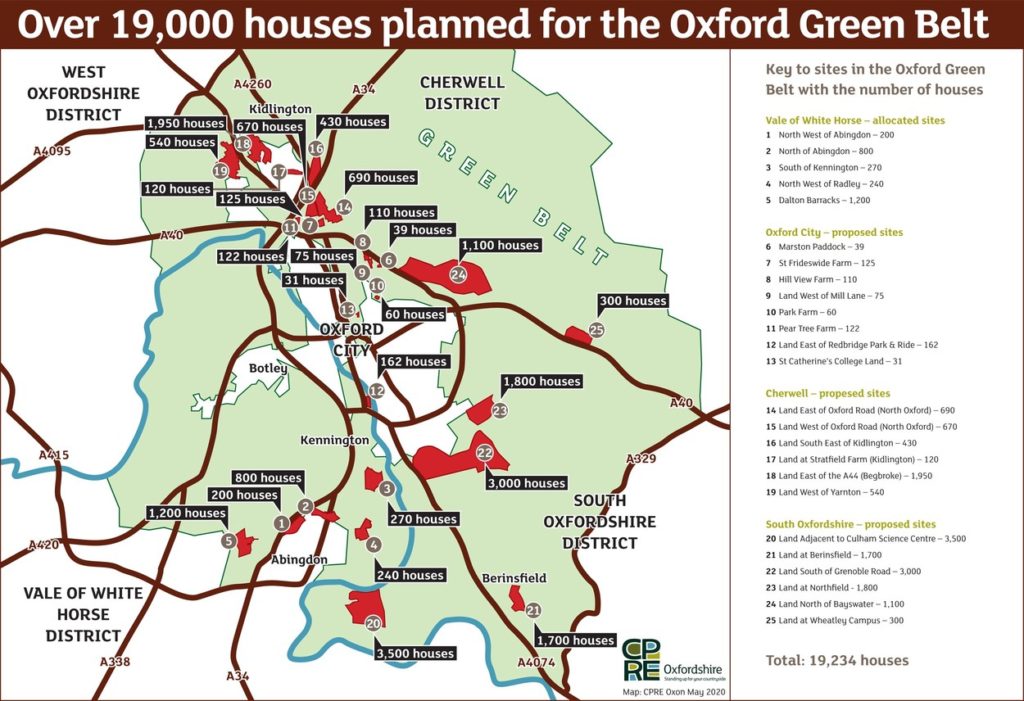Oxford Green Belt

Last modified:
14th February 2024
CPRE Oxfordshire campaigns to protect and enhance the Green Belt.
Our key goal is to persuade local authorities that the Green Belt should not be built on other than in genuinely exceptional circumstances, where the development is widely accepted as in the public interest and when it could only achieve its purpose if it were located on Green Belt land.
Our Vision for the Green Belt
In the future, the Oxford Green Belt will continue to be highly valued by decision-makers and local residents for the planning benefits it delivers. This includes encouraging urban regeneration, preventing urban sprawl and the coalescence of settlements, and protecting both the historic city and surrounding countryside.
The vital additional benefits it can offer will also be widely recognised and valued, including its importance regarding climate change, nature recovery, health and well-being and food production.
As a result, robust policies will be in place both to avoid development within the Green Belt (other than in genuinely exceptional circumstances) and to enhance the quality of existing Green Belt land. Opportunities to extend the Oxford Green Belt, and the need for the creation of new Green Belts around other major urban areas in Oxfordshire, will be considered.
Most importantly, local communities will have increased access to, and understanding of, the countryside on their doorstep, confident that it will be maintained for future generations.
About the Oxford Green Belt
CPRE has campaigned for decades to preserve and strengthen Green Belts across the country. In the 1930’s CPRE supported the very first initiative of having a ‘Green Belt’ around London to restrain appalling urban sprawl.
Green Belts are not everywhere! Oxford is the only major urban area in Oxfordshire that has a designated Green Belt around it, see interactive map above.
Proposals for the Oxford Green Belt were submitted in 1958 with the outer boundaries approved in 1975 and the inner boundaries nearest the City finalised in the 1990’s. It covers land within the Oxford City Council area as well as parts of all four of the surrounding District Councils – Cherwell, South Oxfordshire, West Oxfordshire and the Vale of White Horse.
Oxfordshire County Council is responsible for some issues affecting the Green Belt, such as the public Rights of Way network and transport infrastructure.
Why we campaign for the Green Belt
The Oxford Green Belt is irreplaceable – once it is lost to development, it is gone forever.
Today the Oxford Green Belt is under heavy pressure: its boundaries are being eroded by city-related development and its identity is being re-branded as ‘a rural-urban fringe’. In the last round of local development plans, over 20,000 houses were allocated to the Oxford Green Belt – equivalent to a third of Oxford City, see graphic below.

If this continues, the Green Belt will no longer play its vital planning role as described in national planning policy:
- Preventing urban sprawl
- Preventing merging of settlements (coalescence)
- Protecting the countryside from encroachment
- Preserving Oxford’s special character and setting
- Encouraging urban regeneration.
The Oxford Green Belt also fulfills other vital roles:
- The Green Belt provides the ‘countryside next door’ to the city and surrounding villages which is easily accessible for all kinds of recreation to improve and maintain mental and physical health, thereby reducing pressure on the NHS.
- The vegetation in the open countryside surrounding Oxford provides a carbon sink: absorbing carbon emissions created through human activity. Protecting our carbon sinks is an essential means of tackling climate change.
- The Green Belt is the city’s ‘green lung’ offering a large area of open countryside and clean air for all local people to enjoy, as well as supplying the source of unpolluted air which reduces air pollution levels within Oxford City.
- Farming and food production is an important priority to provide the security of locally sustainable food supplies in the Oxford Green Belt, with around 24,000 hectares in agricultural use.
- The Green Belt supports wildlife and biodiversity, providing wildlife corridors, species migration routes, nature networks and helping to restore habitats across open countryside.
- The Green Belt provides important resilience to the risk of flooding for rural and city communities: trees, hedges and planted fields catch rainfall, absorb water and slow water flow.
What we think
There are some good policies in place to protect the Green Belt, but these are not always being acted upon. We need our local decision-makers to be more robust in their protection of the existing Green Belt. We also want them to show more ambition in increasing and enhancing Green Belt land so that, as well as the planning benefits it offers, it can fulfill its potential as a vital resource for tackling climate, health, biodiversity and food security challenges.
- Our local authorities should only allow development on the Green Belt in genuinely exceptional circumstances, which should be defined as where the development is widely accepted as in the public interest and when it could only achieve its purpose if it were located on Green Belt land.
In a speech, Dec 2023, Secretary of State Michael Gove said that “The new NPPF now, more clearly, upholds the spirit of the original intention. Local authorities have the comfort of knowing that they need not re-draw the green belt or sacrifice protected landscapes to meet housing numbers.” We very much hope that this proves to be the case.
- Our local authorities should be more proactive in planning positively to enhance the beneficial use of the Green Belt. The NPPF describes this as ‘looking for opportunities to provide access; to provide opportunities for recreation; to retain and enhance landscapes, visual amenity and biodiversity; or to improve damaged and derelict land’. We would like to see much stronger policies and programmes to reflect this, especially in the next round of Local Plans that our local authorities are currently preparing.
- Preserving and improving access to the Green Belt should be a priority. The network of cycle and walking paths through the Green Belt needs to be maintained and promoted so that local people can discover and protect the open countryside on their doorsteps.
Access to the countryside and green spaces clearly has a role to play in encouraging healthy lifestyles, physical and mental well-being and building resilient communities. There are around 240 hectares of open countryside with public footpaths criss-crossing the Oxford Green Belt. The Oxford Green Belt Way, created by CPRE Oxfordshire, provides a 50-mile circular walk designed to be accessible via public transport.
- Consideration should be given both to enlarging the Oxford Green Belt and the creation of new Green Belts at Bicester and Didcot.
The NPPF suggests that any removal of land from the Green Belt can be offset with improvements to the quality and accessibility of the remaining Green Belt land (NPPF para 142).
The NPPF also gives some scope for the creation of new Green Belts, albeit in limited circumstances (para 139). In areas where Oxfordshire has faced high levels of development and loss of green space, such as Didcot and Bicester, a new Green Belt could prevent further urban sprawl, provide existing and new residents easy access to surrounding countryside and offer permanent protection to a designated band of open countryside.
- Renewable energy developments in the Green Belt should be considered inappropriate development, unless they are small in scale and avoid harm to the landscape.
Renewable energy is vital but the priority should be to channel such development to brownfield sites and rooftops, as well as embedding requirements for energy insulation and renewable energy measures in all new development.
CPRE believes solar farms and wind turbines are not generally appropriate in the Green Belt due to their significant visual harm and industrialisation of the landscape.
To ensure that further renewable energy provision is brought forward rapidly, but in a manner that is sensitive to broader environmental, landscape and heritage constraints, CPRE Oxfordshire is campaigning for a county-wide strategy, supported by public consultation and engagement, setting out the amount and spatial location for renewables projects. Read more about our position on renewable energy here.
What can you do?
- JOIN CPRE and help us campaign to preserve and enhance the Green Belt.
- Tell your councillors & MP – let your local District & County councillors and your MP know how important the Green Belt is to you and why they should protect and enhance it. Not sure who to contact? See: www.writetothem.com
- Help us spread the word – Follow us on social media and keep in touch with our Green Belt actions. Could you support or help us organise a public event or activity in the Green Belt? Perhaps you know a school, organisation or local community group that would be interested in a presentation or an environmental workshop? Maybe you know of local events where we could bring a stall, or a local newsletter where we could publicise our work? We’d love to hear your ideas.
- Hands on action – are there practical projects that could help enhance the quality of or access to an area of Green Belt land? We’re always happy to discuss.
Summary of Government Policy
The National Planning Policy Framework (Dec 23) says that The Government attaches great importance to Green Belts. The fundamental aim of Green Belt policy is to prevent urban sprawl by keeping land permanently open; the essential characteristics of Green Belts are their openness and their permanence (para 142).
At para 143 it lists the five core purposes of the Green Belt as being:
a) to check the unrestricted sprawl of large built-up areas;
b) to prevent neighbouring towns merging into one another;
c) to assist in safeguarding the countryside from encroachment;
d) to preserve the setting and special character of historic towns; and
e) to assist in urban regeneration, by encouraging the recycling of derelict and other urban land.
Para 144:
New Green Belts should only be established in exceptional circumstances, for example when planning for larger scale development such as new settlements or major urban extensions.
At para 145 it says:
Once established, there is no requirement for Green Belt boundaries to be reviewed or changed when plans are being prepared or updated. Authorities may choose to review and alter Green Belt boundaries where exceptional circumstances are fully evidenced and justified, in which case proposals for changes should be made only through the plan-making process.
At para 146 it continues:
Before concluding that exceptional circumstances exist to justify changes to Green Belt boundaries, the strategic policy-making authority should be able to demonstrate that it has examined fully all other reasonable options for meeting its identified need for development.
This includes:
- Making as much use as possible of brownfield and under-utilised land
- Optimising the density of development
- Working with neighbouring authorities to identify possible alternative sites.
At para 150 it says:
Once Green Belts have been defined, local planning authorities should plan positively to enhance their beneficial use, such as looking for opportunities to provide access; to provide opportunities for outdoor sport and recreation; to retain and enhance landscapes, visual amenity and biodiversity; or to improve damaged and derelict land.
Section 13 of the NPPF – Protecting Green Belt land (paragraphs 142-156), can be read in full on the Government website here.
